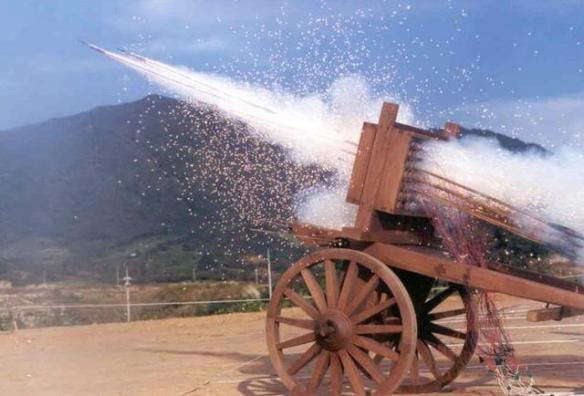Multiple rocket-launcher The Koreans possessed an array of ingenious artillery weapons. These included the hwacha, a rocket-launcher used with great success both against Japanese land forces and for firing volleys of incendiaries at enemy ships.
Advanced technology helped the Koreans repel their Japanese invaders at the end of the sixteenth century. The so-called turtle ships-small, swift, armored ships covered in iron plating and loaded with canons-were highly maneuverable and could easily penetrate deep into an enemy navy. At the same time, their covering of spiked iron plates made them difficult to board or take down with arrow or gunfire.
Another significant invention was the hwacha, which could shoot a hundred rocket-propelled arrows at once. The hwacha consisted of a two-wheeled cart with a horizontal frame with holes for each of the arrows. During the Battle of Haengju, the Koreans were outnumbered nearly ten to one, but thanks to the hwacha, the Japanese were forced to retreat.
Rockets have been used as early as A. D. 1232, when the Chinese employed them as unguided missiles to repel the Mongol besiegers of the city of Pein-King (Peiping). Also, in the fifteenth century, Korea developed the sinkijon. (or Sin-Gi-Jeon) rocket. Manufactured from the early fifteenth to mid-sixteenth century, the sinkijon was actively deployed in the northern frontiers, playing a pivotal role in fending off invasions on numerous occasions. Once out of the rocket launcher, the fire-arrows were set to detonate automatically near the target area. Also, the high-powered firearm was utilized in the southern provinces to thwart the Japanese marauders. The main body of the sinkijon’s rocket launcher was five to six meters long, the largest of its kind at that time. A sinkijon was capable of firing as many as one hundred fire-arrows or explosive grenades. The fire-arrow contained a device equipped with gunpowder and shrapnel, timed to explode near the target. The introduction of gunpowder made possible the use of cannon and muskets that could fire projectiles great distances and with high velocities. It was desirable – in so far as the study of cannon fire is desirable – to learn the paths of these projectiles, their range, the heights they could reach, and the effect of muzzle velocity. Several years later, the sinkijon went through another significant upgrade, which enabled it to hurl a fire-arrow made up of small warheads and programmed to detonate and shower multiple explosions around the enemy. In 1451, King Munjong ordered a drastic upgrade of the hwacha (a rocket launcher on a cartwheel). This improvement allowed as many as one hundred sinkijons to be mounted on the hwacha, boosting the overall firepower and mobility of the rocket.
Sinkijon means “ghost-like arrow machine.”
